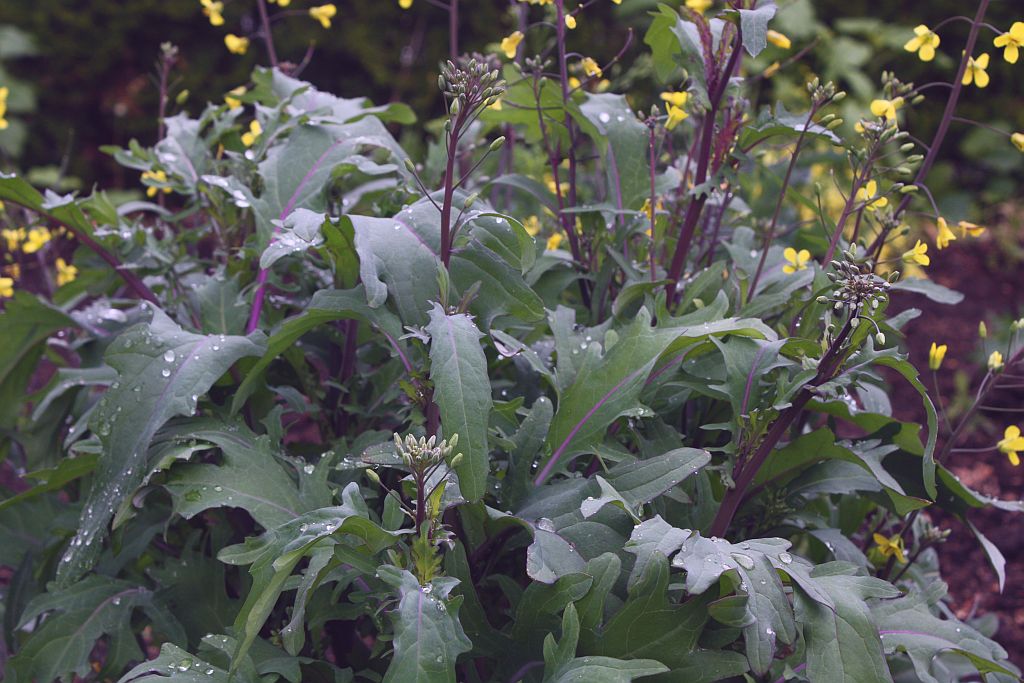If you’re a fan of leafy greens, you’ve likely heard of kale. This superfood is packed with nutrients, making it a popular choice in many kitchens.
But did you know that there are actually several different types of kale? Each type has its unique flavor, texture, and color, so knowing which one to choose can be hard.
Let’s explore the different types of kale and its uses. This is to help you get the most out of this versatile vegetable.
Different Types of Kale
1. Red Winter

Red Winter kale is a flat-leafed variety of kale with deep purple veins and a slightly sweeter flavor than other types of kale.
This type of kale is very hardy and can tolerate colder temperatures, making it ideal for growing in winter.
Red Winter kale can be eaten raw in salads or cooked as a stir-fry. When cooked, its color changes to a beautiful purple-red hue, making it a great addition to any meal.
This kale contains vitamins and minerals, including iron, calcium, vitamin K, and beta-carotene. It is an excellent choice for those looking for different types of kale leafy green.
2. Prizm
Prizm kale is a variety of kale that stands out from the rest due to its unique dark green and red hues.
It’s known for being the sweetest variety of kale, and its flavor is between cabbage and broccoli.
Prizm kale is great for salads, stir-fries, soups, smoothies, and even chips! It can also be used as a garnish or decoration on dishes.
It’s highly nutritious and contains vitamins A, C, and K, and other minerals and fiber.
3. Curly
Curly kale is among the different types of kale and the most common. It has a bold flavor and crisp texture. It’s perfect for raw salads or cooked dishes.
It’s easy to prepare: remove the thick stem and wash and tear the leaves into pieces.
Curly kale can be used in soups, stews, stir-fries, smoothies, casseroles, salads, omelets, and more. The leaves can be steamed or sautéed and added to vegetable dishes.
This type of kale also makes a great addition to soups and stews.
4. Lacinato
Lacinato, also known as dinosaur or black kale, is a nutrient-packed member of the Brassica family.
Its dark blue-green leaves are deeply ridged and tender, with a slightly nutty flavor.
Lacinato kale is popular for raw salads or as a cooked vegetable. It can be enjoyed as a side dish, added to soups, or tossed in stir-fries.
The leaves retain their texture and flavor even after cooking, so it is an ideal ingredient for dishes like quiches and frittatas.
This kale is especially high in calcium, iron, and vitamin C, making it a great addition to any diet.
5. Ornamental Kale
According to Wisconsin Horticulture, ornamental kale is also one of the different types of kale, mostly grown for its attractive appearance.
According to Gardener’s Path, the center is typically framed by frilly leaves that can be shades of green, white, pink, red, and purple.
So, ornamental kale is a great option if you want to add a colorful splash to your yard.
Similarly, if you like to make edible artwork, a few leaves added as a garnish will liven up any dish.
6. Siberian Kale
According to Properly Rooted, Siberian kale is related to rutabaga or canola plants, unlike most kale types.
According to Seed Ambassadors, Siberian kale is a cross between two species originating in the Middle Ages.
According to Seed Ambassadors, this type is a wonderful option if you want to grow disease-resistant kale and can withstand both harsh winters and hot summers.
According to Missouri Botanical Garden, it is still a leafy green but a little softer and milder in flavor than other varieties.
This is even though it is not closely linked to the regular types of kale you can purchase in the store. As a result, we endorse Siberian kale as a superior raw salad element.
Siberian kale will provide all the nutrients and a milder flavor for a green smoothie that doesn’t taste overly vegetarian.
According to Seed Ambassadors, this is among the different types of kale that are equally suitable for steaming, boiling, or sautéing.
7. Chinese Kale
Chinese kale, also known as Chinese broccoli or gai-lan, is a cruciferous vegetable popular in Chinese cuisine.
Its long stems and leaves have an intense dark green hue, and its petite florets have a milder flavor than other types of kale.
This leafy vegetable is stir-fried or Steamed and served as a side dish with garlic and ginger. It can also be boiled or sautéed with other vegetables.
Chinese kale is a great source of vitamins A, C, and K, as well as dietary fiber and minerals like calcium, iron, and magnesium.
It can also be eaten raw in salads or blended into smoothies for a nutrient-packed energy boost.
8. Red Russian Kale
Red Russian kale is a popular variety of vegetables with striking leaves. This is one of the different types of kale known for its slightly sweet flavor and tender texture.
Its long, flat leaves are deep green with purple veins and frilly edges. It is an excellent source of vitamins A and C and dietary fiber.
Red Russian kale is also packed with powerful antioxidants that help fight against inflammation and disease. It can be used raw in salads or cooked in various dishes.
Add this superfood to your diet today and reap its many health benefits.
9. Redbor
Redbor kale is one of the most different types of vibrant and visually stunning kale.
Its deep purple leaves contrast against a bright green stem, making it an attractive addition to any garden.
This kale is known for its sweet and nutty flavor, making it great for salads and cooked dishes.
Redbor kale is high in vitamins A, C, calcium, and iron, making it a nutritious and tasty meal option. Because it has a soft texture and mild taste, it is great for roasting and stir-fries.
Redbor kale is an easy-to-grow variety that will have you enjoying delicious and nutritious dishes in no time!
10. Baby Kale
Baby kale is one of the smallest and most tender among the different types of kale. It has a mild flavor, soft texture, and vibrant green hue.
This variety of kale is usually sold in pre-washed, pre-cut, and pre-bagged packages. This makes it great for adding to salads or tossing into smoothies.
Baby kale also cooks quickly and is great for sautéing. It’s rich in vitamins A, C, and K and iron, magnesium, potassium, and calcium.
Baby kale is an excellent choice for those looking to add a nutrient-rich green to their diet.
11. Portuguese Kale
Portuguese kale, also known as Couve Galega, is an heirloom variety of kale that originated in Portugal and Spain.
It has dark green, frilly leaves and a sweet flavor, making it a great choice for salads or cooked dishes. It can be cooked quickly, making it a great option for stir-fries or sautéing.
Portuguese kale is easy to grow but does best when planted in cooler weather. It will tolerate cold weather and can be planted early in the spring.
It is a good source of vitamins A, C, and K, fiber, and calcium. Portuguese kale can be eaten raw or cooked, making it a versatile addition to any meal.
12. Walking Stick Kale
Walking Stick kale is unique among the different types of kale because of its long, thin leaves and its delicious and unique taste.
This kale type is often called the “sweetheart of the garden” due to its sweet flavor and tender texture.
It is an heirloom variety that has been around for centuries and is known for its mild flavor and crunchy texture.
Walking Stick kale is best enjoyed raw, in salads or stir-fries, bringing a bit of sweetness and freshness to the plate.
13. Scarlet Kale
Last on our list of different types of kale is the scarlet kale. It is a type of kale that is usually bright red in color and has a mild, slightly sweet flavor.
The leaves are softer and more delicate than other varieties of kale, making it the perfect choice for salads, wraps, and sandwiches.
It’s also an excellent source of vitamins A and C, folate, iron, and calcium.
Scarlet kale has the same health benefits as other types of kale, including fighting cancer, boosting immunity, and aiding digestion.
When cooked, it turns a deep purple hue, making it a great option for dishes that need a pop of color.
Conclusion
Different kale types are cultivated worldwide, including winterbor, scarlet, redbor, Beira, and ornamental variations.
However, you might only find a few types of kale at your neighborhood grocery shop.
You can surely consume plenty of nutrients from this incredibly healthy vegetable. Nutrients include fiber, calcium, and vitamins C and K, no matter which variety you select.
Consider adding kale to tasty and healthy dishes like this white bean and kale soup or these sunflower-coated crispy kale chips.








